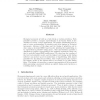Free Online Productivity Tools
i2Speak
i2Symbol
i2OCR
iTex2Img
iWeb2Print
iWeb2Shot
i2Type
iPdf2Split
iPdf2Merge
i2Bopomofo
i2Arabic
i2Style
i2Image
i2PDF
iLatex2Rtf
Sci2ools
NIPS
2007
2007
Modelling motion primitives and their timing in biologically executed movements
Biological movement is built up of sub-blocks or motion primitives. Such primitives provide a compact representation of movement which is also desirable in robotic control applications. We analyse handwriting data to gain a better understanding of primitives and their timings in biological movements. Inference of the shape and the timing of primitives can be done using a factorial HMM based model, allowing the handwriting to be represented in primitive timing space. This representation provides a distribution of spikes corresponding to the primitive activations, which can also be modelled using HMM architectures. We show how the coupling of the low level primitive model, and the higher level timing model during inference can produce good reconstructions of handwriting, with shared primitives for all characters modelled. This coupled model also captures the variance profile of the dataset which is accounted for by spike timing jitter. The timing code provides a compact representation ...
| Added | 30 Oct 2010 |
| Updated | 30 Oct 2010 |
| Type | Conference |
| Year | 2007 |
| Where | NIPS |
| Authors | Ben H. Williams, Marc Toussaint, Amos J. Storkey |
Comments (0)

